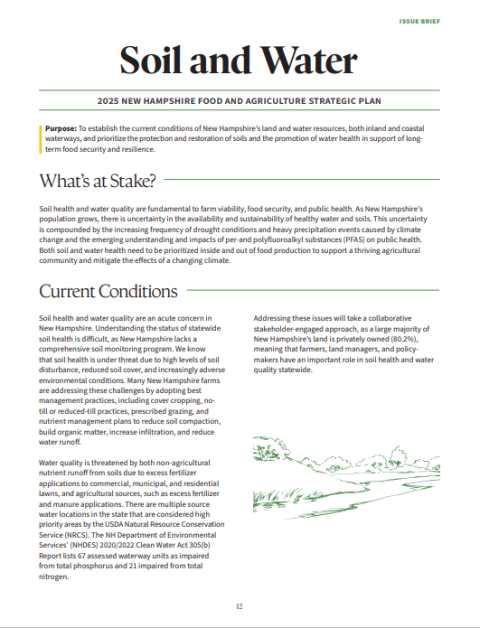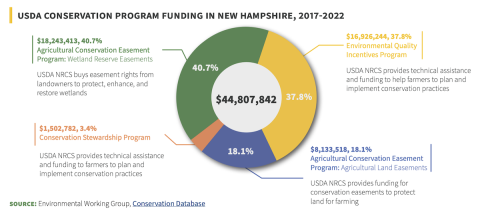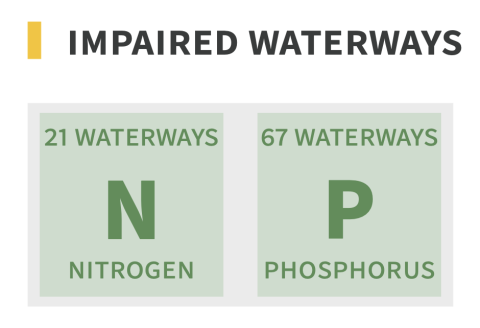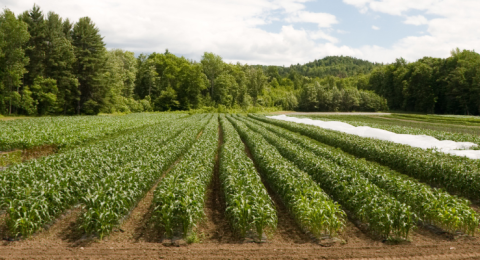
Brief Purpose
To establish the current conditions of New Hampshire’s land and water resources, both inland and coastal waterways, and prioritize the protection and restoration of soils and the promotion of water health in support of long-term food security and resilience.
View the brief as a PDF
What's at Stake?
Soil health and water quality are fundamental to farm viability, food security, and public health. As New Hampshire’s population grows, there is uncertainty in the availability and sustainability of healthy water and soils. This uncertainty is compounded by the increasing frequency of drought conditions and heavy precipitation events caused by climate change and the emerging understanding and impacts of per-and polyfluoroalkyl substances (PFAS) on public health. Both soil and water health need to be prioritized inside and out of food production to support a thriving agricultural community and mitigate the effects of a changing climate.


The Soil & Water brief is one of 27 briefs created as part of the NH Food and Agriculture Strategic Plan. The Soil & Water brief was developed through a participatory process led by the NH Food Alliance. The brief content is comprised of the opinions, perspectives, and information gathered by the authors and participants, and does not necessarily represent those of the NH Department of Agriculture, Markets, and the NH Food Alliance.
DAMF LOGO --- NHFA LOGO?
>> Head to the Strategic Plan main page to read more briefs and learn about the plan, including how it was created.
>> View and download the pdf of this brief, or read the content below.

Current Conditions

Soil health and water quality are an acute concern in New Hampshire. Understanding the status of statewide soil health is difficult, as New Hampshire lacks a comprehensive soil monitoring program. We know that soil health is under threat due to high levels of soil disturbance, reduced soil cover, and increasingly adverse environmental conditions. Many New Hampshire farms are addressing these challenges by adopting best management practices, including cover cropping, no-till or reduced-till practices, prescribed grazing, and nutrient management plans to reduce soil compaction, build organic matter, increase infiltration, and reduce water runoff.
Water quality is threatened by both non-agricultural nutrient runoff from soils due to excess fertilizer applications to commercial, municipal, and residential lawns, and agricultural sources, such as excess fertilizer and manure applications. There are multiple source water locations in the state that are considered high priority areas by the USDA Natural Resource Conservation Service (NRCS).1 The NH Department of Environmental Services’ (NHDES) 2020/2022 Clean Water Act 305(b) Report lists 67 assessed waterway units as impaired from total phosphorus and 21 impaired from total nitrogen.2
Addressing these issues will take a collaborative stakeholder-engaged approach, as a large majority of New Hampshire’s land is privately owned (80.2%3), meaning that farmers, land managers, and policy- makers have an important role in soil health and water quality statewide.
Challenges & Opportunities
Challenges
> A lack of public and political understanding for needed soil health support and its connections to farm viability and food security.
> Soil health is at risk due to increasingly frequent drought and heavy rainfall events caused by climate change.
> The state does not have a statewide, long-term soil monitoring program. Soil testing is offered by UNH Extension and NRCS.
> Water quality is impacted by numerous factors including: added pollutants, including PFAS; the fragmentation or removal of natural filtration and stability systems, such as wetlands and vegetated waterway buffers; and the increased frequency of large precipitation events caused by climate change.
Opportunities
> There are multi-organizational bodies and networks that can promote collaboration between state, local, and federal agencies, universities and researchers, nonprofit organizations, and farmers to identify system needs and create solutions.
> State and federal governments have water quality management programs in place that encourage best management practices.
> Other Northeastern states have healthy soils partnerships, programs, and resources that could provide opportunities for collaboration (e.g., Vermont4 and Massachusetts5).
> Approaches are available to better understand how the timing and size of storms, relative to agricultural activities, influences water quality reaching surface waters, but require investment.
> Practices that improve soil health and increase water retention, such as cover cropping, composting, no- and reduced-tillage, and creating nutrient management plans are supported by NRCS, both financially and through technical assistance.
Measurements & Monitoring
Soil Health Monitoring
In the absence of a statewide soil health monitoring program, preliminary soil health indicators should be synthesized from the number of farmers (and total acreage) who adopt best management practices, including reduced-till or no-till practices, prescribed grazing, cover cropping, and nutrient management plans. The best place to track these metrics would be through the USDA Census of Agriculture, Land Use Practices section6, which relies on voluntary reporting, or through NRCS reporting. From 2017 to 2022, USDA Conservation Program funding in New Hampshire equaled nearly $45 million, mostly for the Agricultural Conservation Easement Program and Environmental Quality Incentives Program.

Responses from the 2022 Census of Agriculture indicate that New Hampshire farms had the lowest adoption of conservation practices among New England states.
Source: USDA 2022 Census of Agriculture, Table 47: Land Use Practices

Source: Environmental Working Group, Conservation Database

Surface Water Quality
Surface water quality is well tracked by NHDES, who monitor stream chemical characteristics, identify impaired waters, and develop Total Daily Maximum Loads reports7. Statewide assessments are published every two years. The Department’s Clean Water Act Section 305(b) Report8 provides important statewide assessments of water quality. Specific attention should be paid to nitrogen and phosphorus levels, and which impaired waterways drain primarily agricultural versus suburban or more developed watersheds. Water quality improvement efforts should target a reduction in surface waterways assessed as impaired for total nitrogen and phosphorus. More specific details on impaired waterways, and those being listed and delisted, can be found in Section 303(d) of the NHDES report.9
Recommendations
Authors
Lead Author
Ian Hanley, PhD, Executive Director, New Hampshire State Conservation Committee
Contributing Authors
Dorn Cox, PhD, Tuckaway Farm, Vice President, New Hampshire Association of Conservation Districts
Steven Keleti, Northeast Health Soil Network
Wilfred Wollheim, PhD, Co-Director, Water Systems Analysis Group, Professor, University of New Hampshire College of Life Sciences and Agriculture
Renuka Mathur, PhD, State Extension Specialist, Soil Health, UNH Extension
Author Acknowledgements
The lead author would like to acknowledge and appreciate the assistance of Don Keirstead and Kim Bakker (NRCS), who provided statistics related to the adoption of best management practices used in the preparation of this brief.
The lead author would like to acknowledge and appreciate the contributions and insights of Advisory Committee editors, Anton Bekkerman (New Hampshire Agricultural Experiment Station) and Katelyn Porter (NH Food Alliance) to the preparation of this brief.


References
1 USDA Natural Resource Conservation Service. FY2023 Source Water Protection High Priority Areas by Resource Concern. Nrcs.usda.gov. Published January 2023. https://www.nrcs.usda.gov/sites/default/files/2023-01/NWQI-Map-Source-Water-Protection-Local-Priority-Resource-Concerns-for-FY23.pdf
2 NH Department of Environmental Services. 2020/2022 Section 305(b) Surface Water Quality Report. Des.nh.gov. Published August 19, 2022. https://www.des.nh.gov/sites/g/files/ehbemt341/files/documents/r-wd-22-11.pdf
3 Headwaters Economics. Public Land Ownership in the United States. headwaterseconomics.org. Published June 2024. https://headwaterseconomics.org/public-lands/protected-lands/public-land-ownership-in-the-us/
4 UVM Extension. State of Soil Health in Vermont. Uvm.edu. Published 2024. https://www.uvm.edu/extension/nwcrops/state-soil-health-vermont
5 Massachusetts Department of Conservation. Healthy Soils Action Plan. Mass.gov. Published 2023. https://www.mass.gov/doc/healthy-soils-action-plan-2023/download
6 USDA National Agricultural Statistics Service. New Hampshire State and County Data, Figure 47: Land Use Practices 2022 and 2017. Nass.usda.gov. Published February 2024. https://www.nass.usda.gov/Publications/AgCensus/2022/Full_Report/Volume_1,_Chapter_1_State_Level/New_Hampshire/
7 NH Department of Environmental Services. Water Quality Assessment and TMDLs. Des.nh.gov. Published 2024. https://www.des.nh.gov/water/rivers-and-lakes/water-quality-assessment
8 NH Department of Environmental Services. (2022, August 19). 2020/2022 Section 305(b) Surface Water Quality Report. Des.nh.gov. Published August 19, 2022. https://www.des.nh.gov/sites/g/files/ehbemt341/files/documents/r-wd-22-11.pdf
9 NH Department of Environmental Services. 2020/2022 Section 303(d) Surface Water Quality List. Des.nh.gov. (Published February 18, 2022). https://www.des.nh.gov/sites/g/files/ehbemt341/files/documents/r-wd-20-18.pdf


